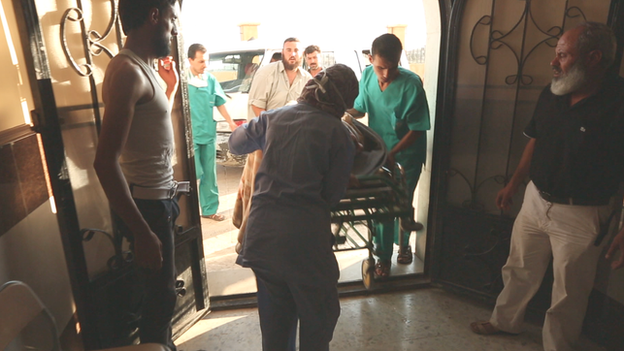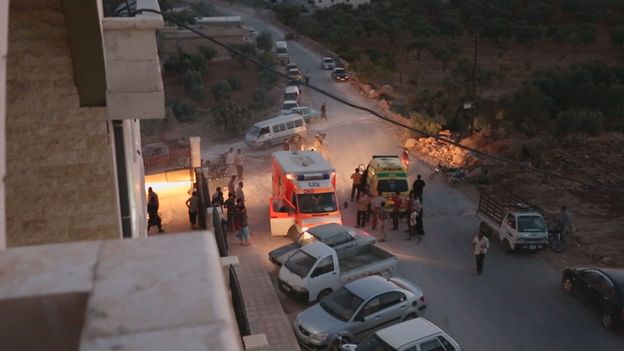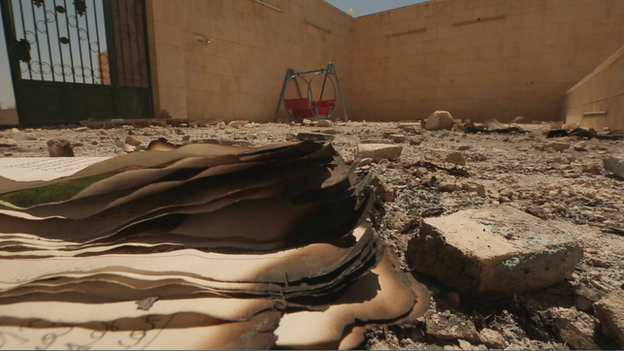Syria: Agony of victims of 'napalm-like' school bombing
- Published
Reporter Ian Pannell and cameraman Darren Conway have returned to Syria to see the progress of some of the victims
Footage of a napalm-like attack on a school in Syria filmed by a team working for Panorama shocked the world. Now the BBC has returned to find out what happened to the children who suffered horrific burns.
We had travelled to Syria to film two British doctors from the UK charity Hand in Hand for Syria, external providing care to parts of the country where the medical system is barely functioning.
The British medics had stopped off at a hospital in Aleppo Province. It was set up by the charity to provide general medical care, but in a climate of war it is just as likely to be casualties of the conflict who are carried through the door.
Within an hour of being there we received the first sign of what was to come.
A seven-month old baby boy arrived, his pink face was blistered and raw. His father was also burnt and sat helplessly on a stretcher clutching his son as the staff rushed to help.
The British doctors were hearing rumours that there were more cases on the way.
Soon, dozens of people, mostly teenagers, were being rushed in on stretchers with napalm-like burns. Their clothes were burnt, their bodies charred and in some cases their hair had melted.
Their faces were brutally disfigured with huge blisters forming over their bodies. Almost in slow motion they lumbered in; shocked and in pain. The smell of burnt flesh was overpowering.
Within minutes the hospital was overwhelmed. Dr Rola Hallam and Dr Saleyha Ahsam began treating the casualties.

The field hospital was overwhelmed by the number of casualties brought in
There were no shrapnel injuries or loss of blood typical of most aerial bombs.
We did not know for sure what the device contained but it caused appalling burns consistent with an incendiary device, containing a substance like napalm or thermite.
The pressure group Human Rights Watch has documented the use of similar bombs elsewhere in Syria.
All of this unravelled in a climate of fear. It happened just days after the chemical attack in the eastern suburbs of Damascus that killed hundreds of people and many were terrified that the same had just happened here.
Doctors ripped open packets of saline fluid and poured the liquid over the victims. The few beds in the emergency room quickly filled up and many of the teenagers were writhing in agony on the floor.
Thick white cream was applied to their bodies to treat the burns, while yet more patients were brought in.
Outside in the hospital courtyard, a water tanker sprayed the crowd so they could clean themselves - terrified that this had been a chemical attack.
Fathers and mothers desperate for news fought to be allowed into the hospital, cursing their president, Bashar al-Assad.
Eyewitnesses described the same thing - a fighter-jet circling overhead, apparently looking for targets. A large crowd had gathered at the school where the incendiary bomb was dropped.
Eighteen-year-old Siham Kanbari had terrible burns to much of her body.
She had been in a maths class when the blast ripped through the window.
One of the youngest victims was 13-year-old Ahmed Darwish.
When he arrived at the hospital he was shaking uncontrollably. The emergency ward was so full he was told to wait in the corridor.

Casualties had to travel to Turkey for intensive care
Dr Saleyha described the scene.
"Out of all the war zones I have ever been to, today has been by far the worst," she said.
"I have never seen anything like that - the fact that they were children, teenagers, same ages as my nieces and nephews."
The hospital admitted 30 patients that day.
Most had more than 50% burns - which meant their chances of survival were less than half.
The injured needed intensive care therapy but none was available in Aleppo's field hospital.
By dusk the chaos began to subside as patients were rushed across the border to Turkey for treatment. Some died on the way.
"I thought it was never going to end," Dr Rola said. "We lost a gentlemen on transfer to Bab-al-Hawa, he had extensive third degree burns.
"We tried to stabilise him and refer him as soon as possible but we weren't able to rescue him. I've never seen a burn that bad.
"I think his face is going to stay with me for quite a long time."

Children were in the school's playground when the bomb landed
Two days after the attack we went to the school.
It had been one of the few to remain open in this part of northern Syria. But when we visited the classrooms were empty.
The smell at the scene and the debris suggest it was an incendiary bomb. It is not a chemical weapon but is classed as a conventional one.
More than 100 countries have banned their use against civilians but Syria has not signed the treaty.
The air at the scene was still thick with the smell of whatever was dropped that day; it is hard to imagine or to describe the horrors of what the pilot did.
The headmaster said he felt helpless. He was too afraid to give his name.
"The worst thing in life is for someone to die before our eyes.
"People burning in front of you. People dying. People running. But where will they run to?
"They're not safe anywhere. This is the fate of the Syrian people."
Ten children died in the attack and many more have been left struggling to survive terrible burns.
'Please let it be over'
We visited Ahmed, in a Turkish hospital, a few weeks after the incident. Described as a hard working boy with a smiley face, he now has 40% burns to his body.
"I'm in a lot of pain," he said. "I had a fever all last night. I'm in pain on my neck and my shoulder.
"Why bomb us while we are at school. Why?"

Siham had been in a maths class when the attack happened
When we last saw Siham, in the Aleppo hospital, she was screaming in pain. She is now in a ward alongside Ahmed, in Turkey. She told us the day we visited that her body still feels like it is burning.
She was in her final year of school. Described as one of the smartest in her class she is now suffering with 70% burns.
"Please let it be over now", she said. "We need to find a way out. We've had all we can take."
As the controversy over chemical weapons dies down, the world's attention will once again move on from Syria.
But for those whose lives are being torn apart by war, the suffering continues.
Panorama: Saving Syria's Children, is available in the UK on the BBC iPlayer. It will be broadcast on BBC World News on 5 October at 0910 and 2110 GMT, and on 6 October at 0210 and 1510 GMT.